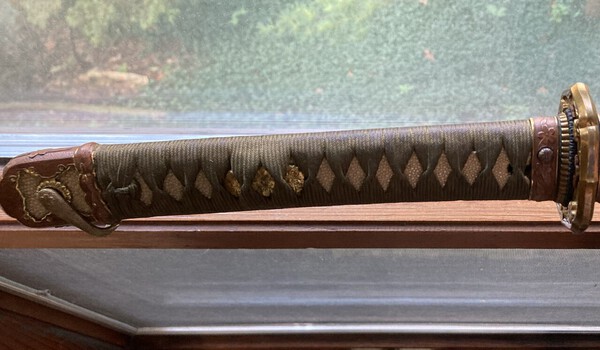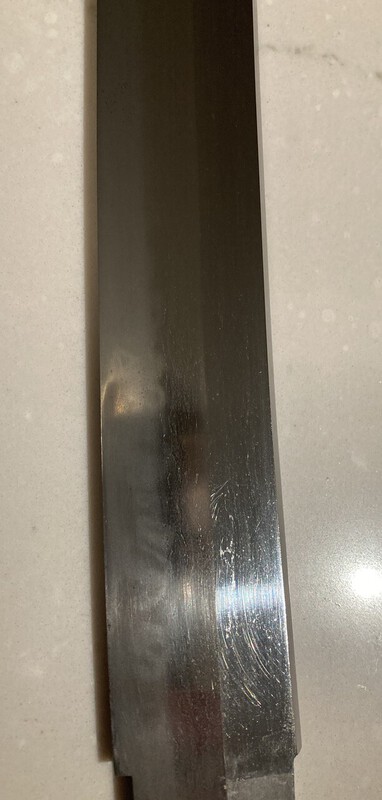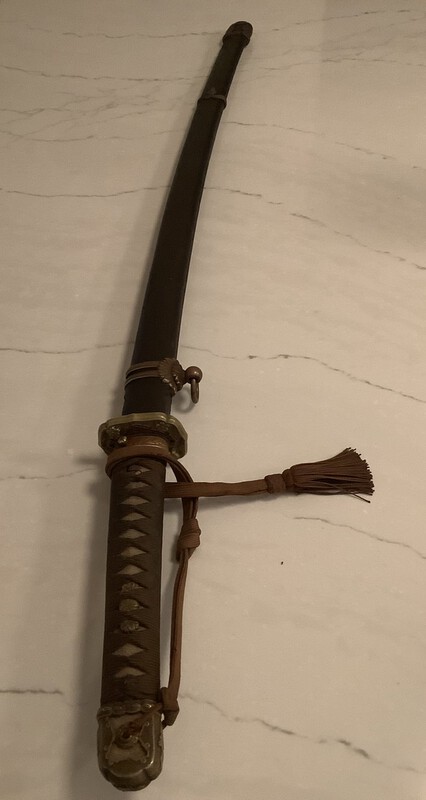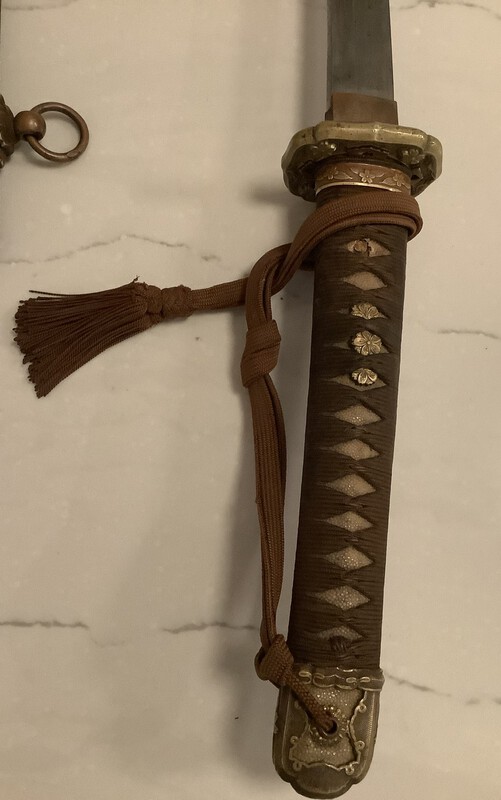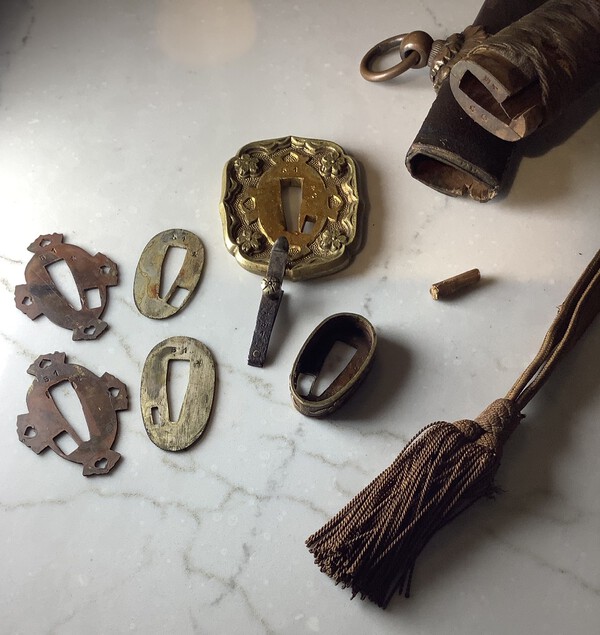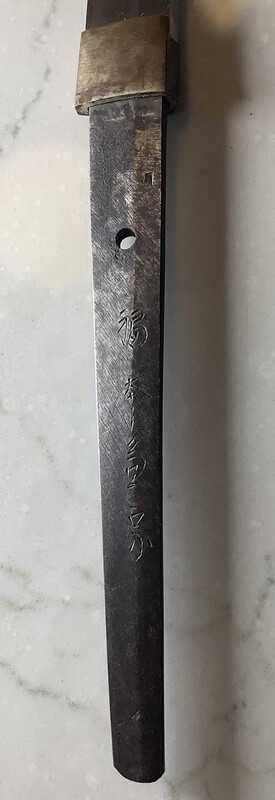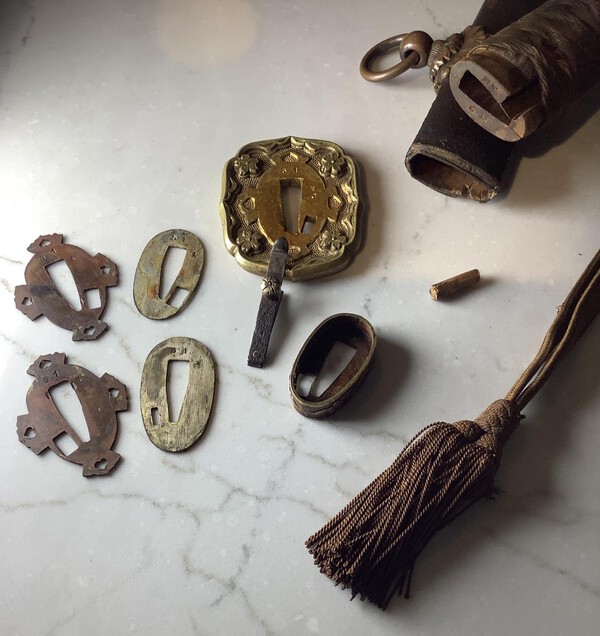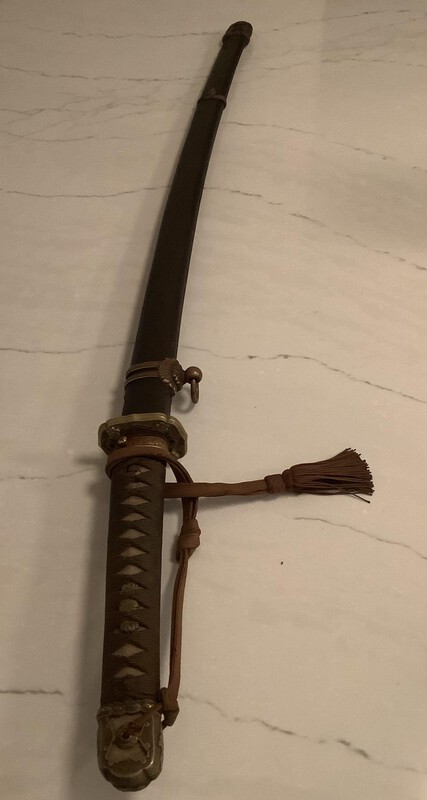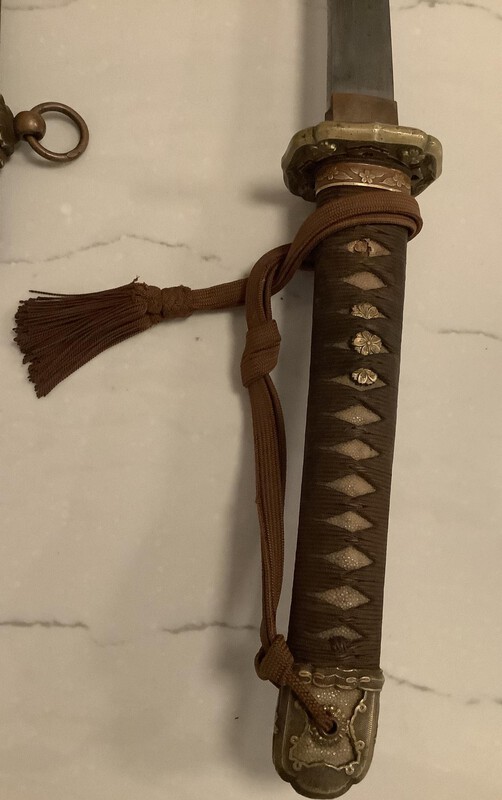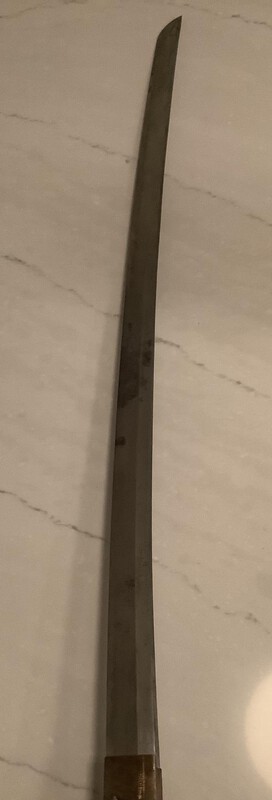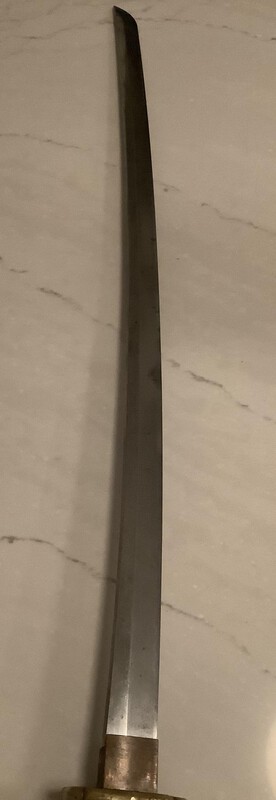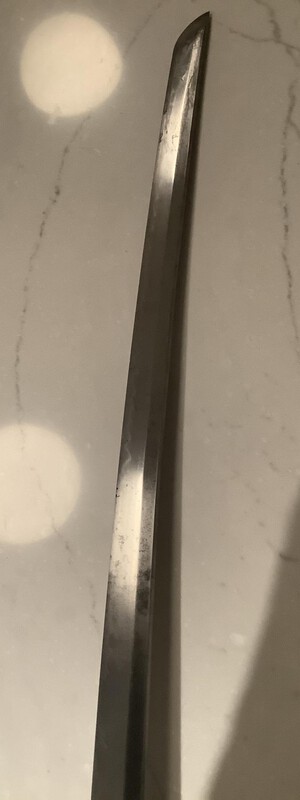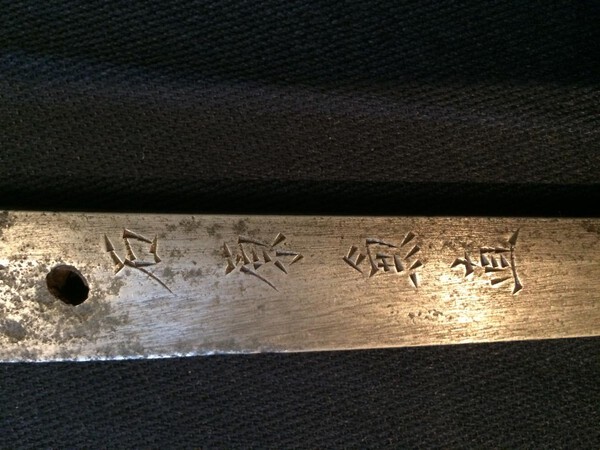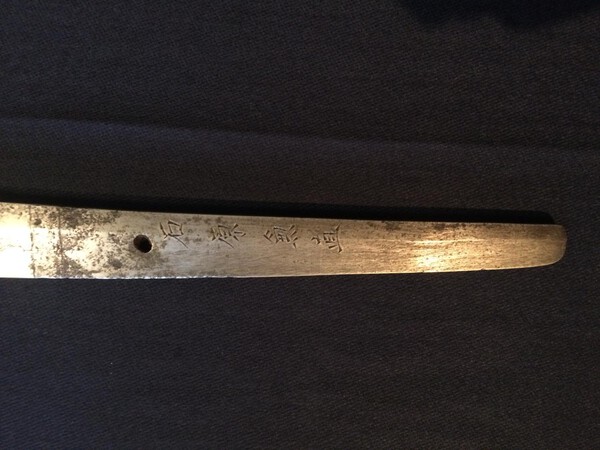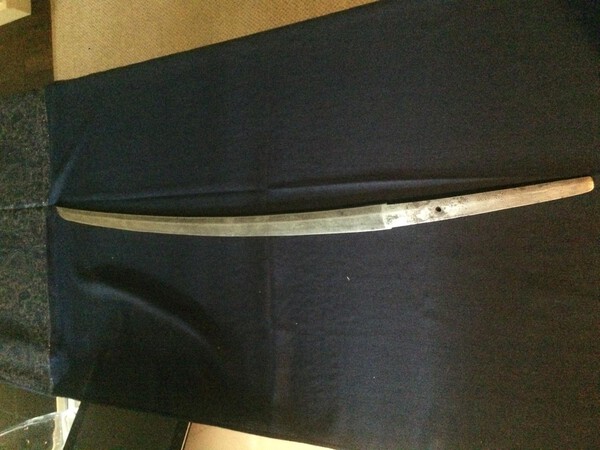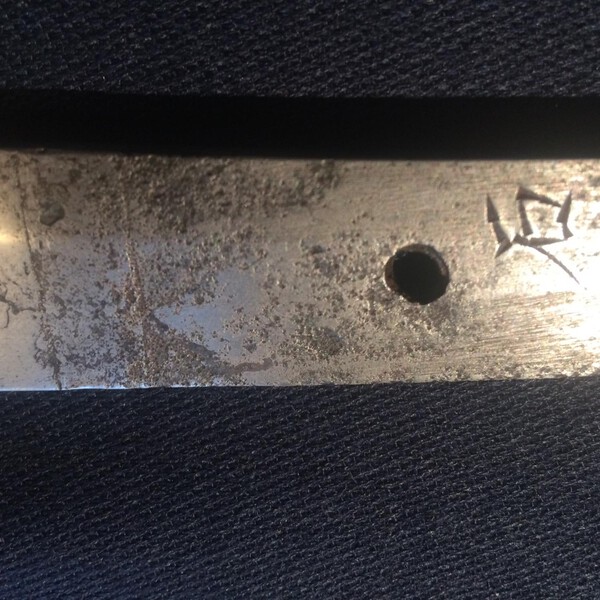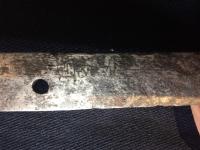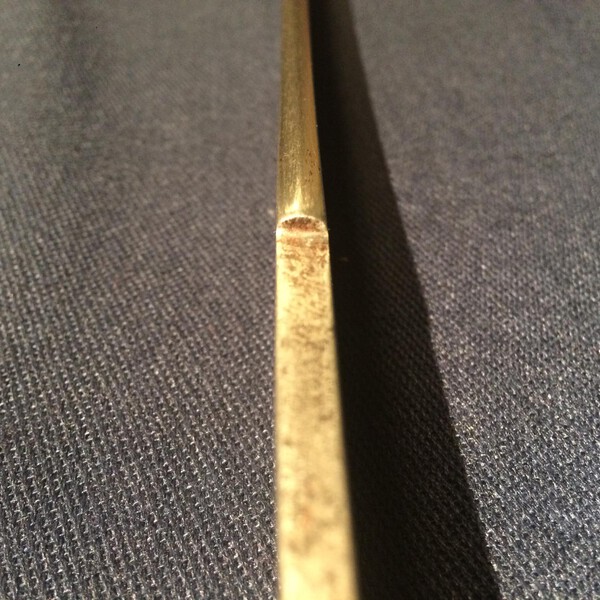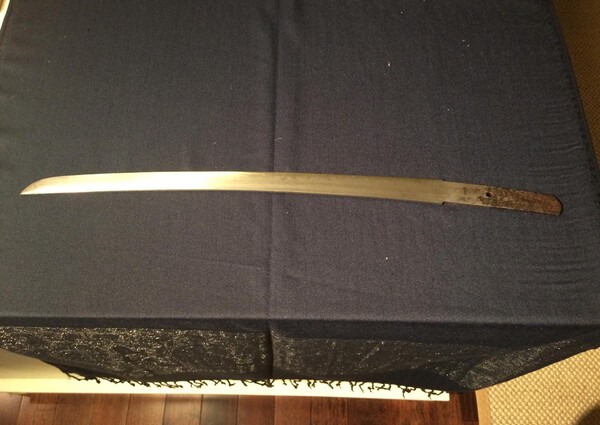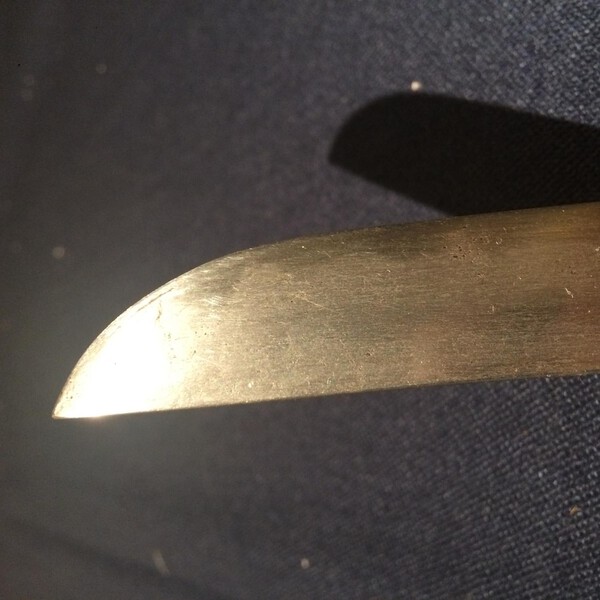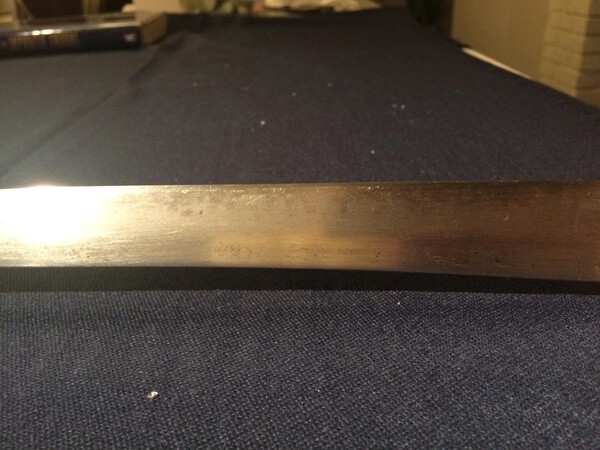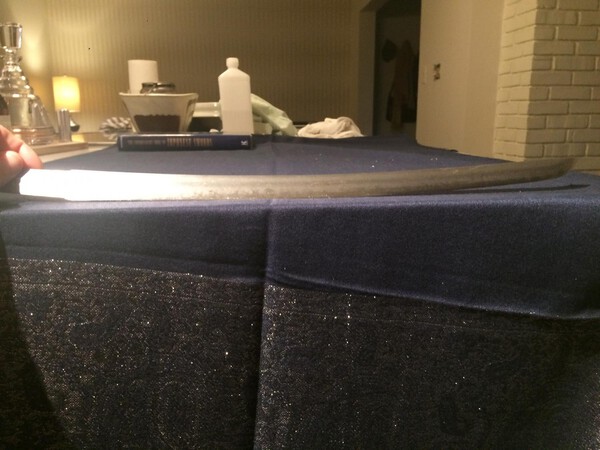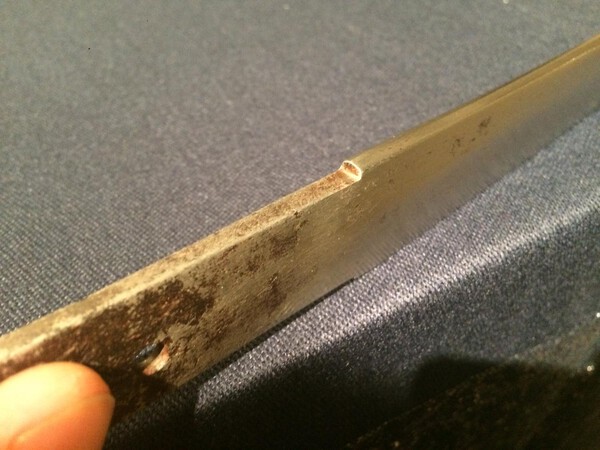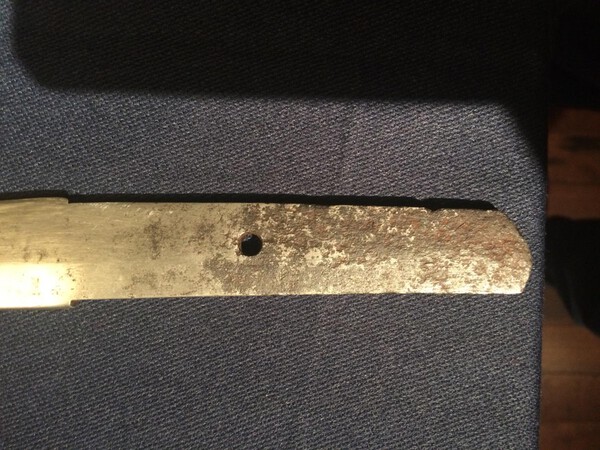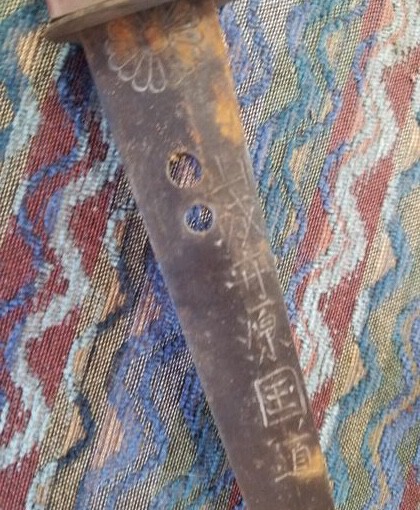-
Posts
57 -
Joined
-
Last visited
Content Type
Profiles
Forums
Events
Store
Downloads
Gallery
Everything posted by Mortis
-
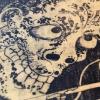
Bamboo Leaf pattern Tsuba on Gunto with old blade
Mortis replied to Baka Gaijin's topic in Military Swords of Japan
-
Steve - Thanks for breaking it down like that. I would say that the mei and nengo on this blade does not look like his finest work. Bruce - Here’s a photo of the tsuka. The koshirae looks like a pretty fancy rig. Full set of graduated seppa, thick tuba, gold colored menuki, the tsuka/same is a full wrap that is reinforced with a metal band at the top (never saw that before.) If only the metal saya didn’t have so much paint loss. Neil - Nice! Nicely signed. Based on the hamon and hada on the blade that I have, Kanetoshi looks like a smith to seek out to collect. Plenty to look at. I think it was Brandon Reeder that had a nice looking Kanetoshi on eBay a few months back that “had a slight bend”, but the hamon was very interesting. I took a hard look at that sword. John - That sword has less seppa than the one that I have, but the rest of the koshirae looks very similar. I wonder if there’s a correlation to Kanetoshi and the koshirae maker that outfitted blades that he made. Green ito, etc. Dave - Thank’s for posting those.
-
Thank you for your replies. -Mr. Hennick. I wonder if this is a glitch with the new format? The font color is always black, right? I’m not sure how to make it visible for both the light and dark background formats. Before I post something like this, I usually write it out in another document, copy, and paste it. Possibly that is why. If you are aware of how to accomplish that, please do not hesitate to tell me. I’m here to learn. Maybe you could switch back to the light mode real quick to be able to read it. -SteveM. This is not the first time that you’ve helped me with a translation. I thank you. Please forgive my ignorance. Is that what it reads literally, Showa 18? If not, would you be so kind to break it down by each individual kanji?
-
Would anyone be so kind as to post a/the page from John Scott Slough’s book showing the information and oshigata for the sword smith Kanetoshi? Shoka Kanetoshi or Murayama Kanetoshi - I’m guessing Murayama based on the “flamboyant” choji hamon and also this blade has some very nice hada (which I understood as somewhat rare in Gendai blades - please correct me if I’m wrong.) There are several examples of a Kanetoshi mei online, but all are significantly longer. I was unable to find an example in nijimei. The nengo looks rather “sloppy.” My shot at translation was Sho-Wa-Ju-Roku-Nen, but I can’t figure out what that correlates to. Another question would be regarding the green ito. It seems that gunto with green ito are few and far between. Am I wrong about that? As always, thank you so much. I am grateful for your expertise and help.
-
You fellas fast with your replies. I appreciate it. Chris - Would you have any photos of examples. I’m struggling to picture how that looks and/or the technique to pass the needle through the ito to negotiate around the menuki. Jean - I like the sound of stop fray, rather than carpenters glue for this issue.
-
Looking for some advice on how to shore-up some ito that is starting to fray and cause the menuki to become loose. Unfortunately one strand has already broken off and of course, I am worried that it will start to unravel completely. About the only technique that I could find online (tameshigiri.com) was: “Loose Tsuka-ito: You can extend the life of your handle wrap by impregnating it with glue. This is a fairly effective technique that does not seriously "uglify" the tsuka. Do not wait until the ito is completely frayed or just hanging in there by a few threads. This fix works best on a handle wrap that is loose but mostly intact. Use a good quality carpenter's (yellow) glue and use your finger to carefully work the glue into the ito until it is saturated. You may need to do multiple applications but make sure to let each layer dry overnight. Being extra careful during the application will give you a superior looking tsuka that will not look much different. The tsuka may feel "sticky" the first few times you use it and some excess dried glue may come off on your hands. This is only temporary and goes away qickly.” Also from tameshigiri.com, there is a description on cleaning the ito wrap: “Cleaning the Handle Wrap (Courtesy of Paul Smith): Take some woolite in a dish and a soft toothbrush. Wet the toothbrush and touch it to the woolite. Gently scrub the ito until it's clean. You'll have to get more water on the toothbrush and more woolite periodically. Once you are done scrubbing, take a wet cloth and wipe down the ito several times, then take a dry cloth and wrap around the handle and squeeze it to get excess moisture out of the ito. Let dry for at least 24 hours before using. Don't scrub too hard because that will roughen the silk. You do want to work quickly, but as long as the water doesn't sit on the tsuka for hours, it won't hurt anything. Do not get any water down inside the tsuka. It is obviously much easier to do this with the tsuka off of the nakago if you can remove it.” If you have ever attempted either of these or something similar please share your experience. I know that sometimes things are better left well enough alone and after starting something like this, maybe you wished that you wouldn’t have. Any thoughts, good, bad, or indifferent would be much appreciated. Thanks a lot. Justin
-
This sword has been sold. Thank you to all who had expressed interest. Can be moved to the sold section of the forum if that is the proper protocol.
-
Here’s one. All of the other fitting numbers match, so I can’t imagine the tassel isn’t original as well. This sword was found wrapped in a blanket in the rafters of a barn in Pennsylvania. Those that I obtained it from weren’t collectors. With that in mind, I highly doubt it was added at a later time.
-
Bump
-
Feel free to make a reasonable offer. Terms subject to change concurrent to negotiation of price and any potential offer/acceptance.
-
Gunto with a Seki stamp signed by Fukumoto Kanemune. 25.5” nagasa / 37” overall in koshirae The koshirae is in really nice shape; all matching numbers with a tassel. Ito is tight and in excellent condition. The saya is wooden and has a few nicks here and there, but unfortunately is missing the koiguchi. However, the blade does fit tightly and is retained within the saya without issue (takes some effort to draw the blade.) The blade has some staining (oxidation?)and toward the kissaki it looks like it has done some cutting. No bends, cracks, or rust though. The hamon is readily visible throughout the blade. The nakago looks to be finished quite nicely for a Seki gunto (only my novice opinion.) All in all a nice honest and original gunto that shows some signs of age, wear, and use. A clean example that I imagine looks much as it did when it was brought back from Japan (again only my novice opinion.) The cool back story on this blade is it was found wrapped in a blanket hidden in the rafters of a barn in Pennsylvania. SOLD Donation to be made to the NMB for providing us the forum to even do this. Thank you all for taking the time to look. I realize the photos are not of the greatest quality. If any additional may be wanted or needed, please don’t hesitate to ask.
-
I would be very interested in gleaning methods of constructing a paper saya. I'm sure that much of Ray's free time is being consumed with this new collection intake. If anyone else has done this and would be able to show examples or post a brief tutorial and or explanation it would be extremely appreciated.
-
Hello Gentlemen, Just looking for confirmation on this mei. I read it as Ishihara Kanenao. Which, if correct would make the blade a gunto/showato. This mei, I think, looks much more “crisp” than other examples (which I don’t know how to link.) The nagasa is 25.5”. The nakago measures 8.11” and is finished in sensuki. It also has a nice sori at 3/4” or so. However, I cannot find any kind of arsenal stamp. Please excuse the rotated photos. It is absolutely maddening to me that I can’t figure out how to prevent this from happening. I’ve done a search on the board for help, but can never find anything, even though I’ve read other posts, numerous times about how to prevent that. I want my posts to be presented in the best possible way, so they can be useful, I can be taken somewhat seriously, and so that other, more learned board members don’t get frustrated. Could someone maybe que me in, send me a pm, or something, so I can stop cluttering up the NMB with misoriented photos? I would really appreciate that.
-
Again, it is utterly amazing to me Ray, that you can pull that mei out of there. Also, thank you for spelling it out for the new folks to the study, with the graphics, and an example from another sword. Just wonderful, so we can see what you are seeing, and it really does help. Now I'm like, "oh yeah ok, I can see that." Thank you very much for presenting it in that manner.
-
Thank you Kirill for your valuable input and suggestions. [ I would invest some time into looking how these "ichimonji" peaks look in detail (crab claws or not), which period the sugata matches the best etc. ] Would you be able to point me in the right direction and/or expand on you point? More so regarding the part about the detail of the "ichimonji" peaks. I also fear that I may not be able to get a great read on sugar a due to the abuse this blade has seen. My nihonto library is quite small. Any additional advise would be much appreciated.
-
Thank you Uwe and Jean for adding to the discussion. These three quotes I feel are extremely salient points that the new collectors (myself especially) should pay very close attention to. As a new collector it is often hard at times to set aside the uh....emotional aspect of it and not get caught-up in the simple fact that.......hey, it's a Japanese sword! But an approach with a level head, efficiently evaluating all aspects of the blade, maybe even more so, for the blades that aren't in the greatest shape to begin with. Or maybe even just don't pursue deficient blades until a certain proficiency in the study has been achieved. Thank you again gentlemen for bringing to light points that I hadn't fully considered and overlooked. Edit @ 4:21p.m.: I'd also like to thank Ron for his contribution as well. More excellent points added to the discussion.
-
Thank you, Mr. Singer. I see what you mean. I could see and feel the ridge and deep-down suspected that what you describe might be the case. I have never seen a true maru-mune for comparison. The blade has certainly been abused. Thank you again for commenting. I must say that I am quite frequently impressed that you always seem to be able to read the faintest mei from the most beat-up of nakagos’. So, in regard to Mr. Singer's lightning fast kantei, may it be supposed that this blade is most likely an kazuuchi-mono (inferior and mass produced.) With the hamon showing yaki-kuzuri and in partial kani-no-tsume (crab claw) that is not uniform on each side, as is the boshi. I imagine that it would be without question that really any type of restoration would not be financially prudent. It is not in very good shape, it is looking pretty tired, but it has still has survived for hundreds of years. Ending up again as a bare blade, in my hands, in the year 2019. And for just that simple fact alone I am always continually amazed by nihonto.
-
I’m sorry. I know it’s been discussed innumerable times, but I can’t figure out how to correctly orient some of the photos.
-
Gentlemen, Here’s a wakizashi with a maru-mune that I acquired from a let’s say, “nihonto box lot” at an auction last fall. I had been hoping to find some nihonto that didn’t cost much, that I could handle and study, maybe even improve and rescue, without having to worry about doing them any harm. This was one of three. I don’t know much, but I knew that a maru-mune was fairly rare. By the nakago, it looked like it could be old and it did have a mei. The bad things were, it was just a bare blade (does have a nice copper habaki though), it was fairly tarnished, and whoever had it before, tried some modern sharpening method on it. Its definitely out of polish and looks pretty tired in places, but I wanted to “rescue” it along with the other two and hopefully learn something along the way. So, I call upon the wisdom of the NMB. I figured I’d just post some measurements and photos to hopefully generate some discussion. Mr. Raymond Singer always seems to be able to provide some feedback with these types of posts, so I’m hoping he would be generous to provide his opinions and expertise. It would be great if the mei could be translated or maybe discuss what schools or smiths forged maru-mune. If I could provide better or different photos please don’t hesitate to tell me. Nagasa: 17.5” Nakago: 5.5” Kasane: .75” Hamon: Saka hamon toward the nakago. Seems to change to gunome toward the kissaki.
-
Gentlemen, An update. This sword was up for auction at a mom & pop auction house today. The auction was in progress by the time I had made it and the sword was put up for sale one-half hour or so after I had arrived. I was able to look the sword over briefly, but was not able to take any photographs. They wanted it back in the display case, so close to the sale time. So, it definitely had many of the common kantei points for a Mishna School blade (which I just learned of in the past few days....thank you, Martin). Nagasa was 22 inches; ubu iriyamagate nakago-jiri w/ two mekugi ana; thick sudare/kikusui hamon; boshi was omaru (i think) with muneyaki; the ha-machi was very substantial. The polish was old, the blade was a "milky" color, but was rust and ware free, and it was still very sharp. I couldn't make out any hada, but I didn't have very much time to concentrate on that. It seemed overall that this blade was very well taken care of and the sudare/kikusui hamon, was really cool to see. It also had some hardened circles (tobayaki?) here and there above the hamon. The blade was mounted. The mounts looked old and were not in the greatest shape. Everything was there, except for one seppa. And the horn kojiri on the saya end was broken in half and it was also loose within the saya. Menuki were of dragons, shakudo I would guess (they were totally black), but were pretty grimey. The fuchi and kashira had some detail, but were also rusty and hard to see the theme exactly, but were also dragon related I would say. Habaki was copper, but I thought I could see some remnant of gold foiling. The tsuba was an iron plate (somewhat rusty) with a kiku / Satome look. I was handily outbid. The sword sold to a phone bidder for $2,200.00, I believe. Which I felt was probably about right considering that, to make it look nicer and "fix" some things with the koshirae, you'd have to spend several hundred dollars more on it. I know it's hard to say without viewing it in hand and based on my weak description, but the "value" is something I'd be interested in hearing more opinions on. I knew it was a good blade, but I was hoping to "steal a deal". At that dollar figure, without a lot of extra money to blow and a wife that "tolerates" this somewhat expensive hobby, I always feel that once you get into even the low-low four figures, I'd rather save my money to spend on blades from dealers that are in better shape, maybe papered, etc. But I imagine there is a special feeling from saving an old sword, that isn't a rusted mess, from just out of the woodwork. Thanks for reading and thank you to the members who have commented throughout the past few days! I certainly know more than I did a week ago and for that I am grateful. ~ Justin
-
Thank you, Martin and Arnold. I too was a bit skeptical of the Dewa Dajo connection after following Martin’s link to further research. Although I’m entirely certain Martin knows far more than I imagine I ever will. I am planning on going to see the sword on Monday. Hopefully I’ll be able to take some additional/better photos.
-
And there it is! Thank you, Jean. Found him on the Nihonto Club website (don't know how to link it). It looks like he wasn't terribly prolific, being active for only twelve years. I suppose this could mean that his blades are fairly rare, but maybe hard to discern the quality of his work, due to few examples. Would this line of thinking be somewhat correct? Or, is the kikumon, in and of itself an implied mark of quality? I would have thought that one would have had to practice for more than twelve years to have the kikumon bestowed upon them.
-
Gentlemen, Here is a blade with a kikumon, but the mei looks fairly “shaky” to me. Not a strong, crisp mei that one would expect from a smith given the right to use the kikumon. What do you all think? I’m terrible at reading mei, I can’t read the first three kanji, but my best guess for the last three is Minamoto Kuni Sada. Doing some internet research I can’t find any smith who used this mei. Thank you for your opinions.
-
☝???? Morphy's had one a few months ago that sold for $1800ish I believe. Might have been over 2 grand though, too. I can't remember. That auction house is about 1.5 hours away from me . I was thinking about attending this upcoming one just to take in the festivities. I'm not really looking to buy at the moment. Anything look interesting or worthwhile? Most look in fairly less than desirable condition to me.
-
Could it also be the "number of heads taken" hypothesis...???????????






